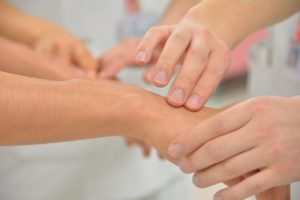De Quervain's Tenosynovitis

De Quervain’s tenosynovitis is a common condition that causes pain and inflammation in the tendons that control the movement of the thumb. It occurs when the tendons around the base of the thumb become irritated or constricted, resulting in pain and difficulty with gripping and grasping objects. De Quervain’s tenosynovitis is a common diagnosis among new mothers and people who perform repetitive wrist motions. This repetitive motion leads to inflammation within the tendon sheath which causes pain. Patients report pain located on the outside of the wrist near the base of their thumb.
The exact cause of De Quervain’s tenosynovitis is unknown, but it is often associated with repetitive motions that involve the thumb and wrist. It is also common in people who engage in activities that require gripping and twisting of the wrist, such as carpentry, knitting, or playing golf. In some cases, hormonal changes during pregnancy can also cause this condition.
The primary symptom of De Quervain’s tenosynovitis is pain and tenderness at the base of the thumb, near the wrist. The pain may extend up the forearm and may worsen with activity that involves the thumb and wrist, such as grasping or twisting objects. Other symptoms include swelling and a creaking sensation when moving the thumb.’
The diagnosis of De Quervain’s tenosynovitis is made based on the patient’s symptoms and physical examination. The doctor may perform a Finkelstein test, which involves the patient making a fist with the thumb inside and then bending the wrist toward the little finger. If this maneuver causes pain, it is a sign of De Quervain’s tenosynovitis. Imaging studies, such as X-rays or MRI, may be ordered to rule out other conditions that can cause similar symptoms.
Treatment for De Quervain’s tenosynovitis
The treatment of De Quervain’s tenosynovitis depends on the severity of the condition. Conservative treatment options include rest, ice, and the use of non-steroidal anti-inflammatory drugs (NSAIDs) to reduce pain and inflammation. In some cases, a splint or brace may be used to immobilize the thumb and wrist to allow for healing. Physical therapy may also be prescribed to strengthen the muscles and improve flexibility.
Steroid injection
Non-operative is the mainstain treatment with steroid injections having a greater than 60% success rate. However if a patient’s anatomy has a separate compartment they are more likely to fail. Therefore often attempt two injections before performing a surgical release.
Operative treatment
Operative treatment is performed by releasing the tunnel that is compressing the tendons. The procedure can be performed under wide awake with local or under sedation. Patients are often immobilized for 2 weeks after surgery and therapy is rarely needed
